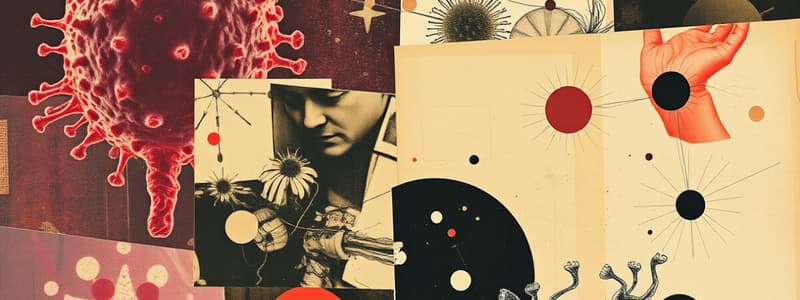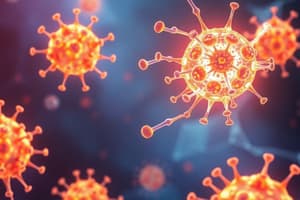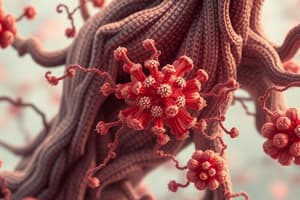Podcast
Questions and Answers
What role do defensins play in the respiratory epithelium?
What role do defensins play in the respiratory epithelium?
- They enhance bacterial adhesion to cell surfaces.
- They secrete mucus to trap dust and microorganisms.
- They create holes in bacterial cell walls, limiting bacterial survival. (correct)
- They neutralize gastric acids in the respiratory tract.
How does the mucous membrane contribute to the respiratory system's function?
How does the mucous membrane contribute to the respiratory system's function?
- By promoting the growth of normal flora in the lungs.
- By filtering air and trapping dust and microorganisms. (correct)
- By facilitating gas exchange between air and blood.
- By producing hydrochloric acid to kill microorganisms.
What is the pH range of gastric juices, which aids in digestive processes?
What is the pH range of gastric juices, which aids in digestive processes?
- 7.0 to 7.5
- 4.5 to 5.5
- 1.2 to 3.5 (correct)
- 6.0 to 6.5
What is the function of ciliated cells in the respiratory tract?
What is the function of ciliated cells in the respiratory tract?
What role does Lactobacillus acidophilus play in the genitourinary tract?
What role does Lactobacillus acidophilus play in the genitourinary tract?
What is a primary benefit of mucus in the respiratory tract?
What is a primary benefit of mucus in the respiratory tract?
In which environments are slightly acidic conditions commonly found?
In which environments are slightly acidic conditions commonly found?
What is the primary function of mucus-coated nasal hair?
What is the primary function of mucus-coated nasal hair?
What occurs when bacterial surface proteins adhere to cells in the respiratory tract?
What occurs when bacterial surface proteins adhere to cells in the respiratory tract?
What is the role of NK cells in the immune response?
What is the role of NK cells in the immune response?
Which component is important for stimulating neutrophils and monocytes during inflammation?
Which component is important for stimulating neutrophils and monocytes during inflammation?
What is NOT a function of the complement system?
What is NOT a function of the complement system?
How do NK cells interact with healthy host cells?
How do NK cells interact with healthy host cells?
What process allows more immune cells to enter the site of infection?
What process allows more immune cells to enter the site of infection?
What is an anaphylatoxin?
What is an anaphylatoxin?
Which of the following statements about complement system is true?
Which of the following statements about complement system is true?
Which receptor is involved in inhibiting NK cell activity against healthy cells?
Which receptor is involved in inhibiting NK cell activity against healthy cells?
Which cells are directly involved in the activation of natural killer cells?
Which cells are directly involved in the activation of natural killer cells?
Which pathway of the complement system is triggered by antibodies?
Which pathway of the complement system is triggered by antibodies?
What is the role of Interferon Lambda in immune response?
What is the role of Interferon Lambda in immune response?
What does the complement system primarily act in conjunction with?
What does the complement system primarily act in conjunction with?
Where are most complement factors produced in the body?
Where are most complement factors produced in the body?
What indicates that a tissue is inflamed?
What indicates that a tissue is inflamed?
Which of the following is NOT part of the cardinal signs of inflammation?
Which of the following is NOT part of the cardinal signs of inflammation?
What is primarily involved in the second line of defense against pathogens?
What is primarily involved in the second line of defense against pathogens?
Which of the following responses is characteristic of fever?
Which of the following responses is characteristic of fever?
What happens when neutrophils and macrophages fail to destroy pathogens?
What happens when neutrophils and macrophages fail to destroy pathogens?
Which of the following is a non-specific defense mechanism?
Which of the following is a non-specific defense mechanism?
Which process is directly involved in the destruction of pathogens in the second line of defense?
Which process is directly involved in the destruction of pathogens in the second line of defense?
What is a major role of the second line of defense?
What is a major role of the second line of defense?
Which of the following statements about the first line of defense is true?
Which of the following statements about the first line of defense is true?
What occurs during the inflammatory response?
What occurs during the inflammatory response?
What type of white blood cells are primarily increased during an immune response?
What type of white blood cells are primarily increased during an immune response?
What are Pattern Recognition Receptors (PRRs) responsible for?
What are Pattern Recognition Receptors (PRRs) responsible for?
Where do Toll-Like Receptors (TLRs) primarily reside?
Where do Toll-Like Receptors (TLRs) primarily reside?
Which of the following is true about Pathogen Associated Molecular Patterns (PAMPs)?
Which of the following is true about Pathogen Associated Molecular Patterns (PAMPs)?
Which immune cells are specifically mentioned as possessing PRRs?
Which immune cells are specifically mentioned as possessing PRRs?
What is one of the main roles of phagocytes in the immune response?
What is one of the main roles of phagocytes in the immune response?
Which statement best describes the sequence of activities performed by phagocytes?
Which statement best describes the sequence of activities performed by phagocytes?
How do macrophages recognize foreign pathogens?
How do macrophages recognize foreign pathogens?
What is the significance of immunogenic information extracted by phagocytes?
What is the significance of immunogenic information extracted by phagocytes?
What distinguishes PAMPs from PRRs?
What distinguishes PAMPs from PRRs?
What is a characteristic feature of the second line of defense in the immune system?
What is a characteristic feature of the second line of defense in the immune system?
Which of the following elements is NOT typically involved in the first line of defense?
Which of the following elements is NOT typically involved in the first line of defense?
What role do interferons play in the immune response?
What role do interferons play in the immune response?
Which statement accurately describes the third line of defense?
Which statement accurately describes the third line of defense?
What is one of the main purposes of phagocytosis in the immune response?
What is one of the main purposes of phagocytosis in the immune response?
Which of the following factors can inhibit the colonization of pathogens on the skin?
Which of the following factors can inhibit the colonization of pathogens on the skin?
What is a typical response of the body when the first line of defense is breached?
What is a typical response of the body when the first line of defense is breached?
Which environmental condition poses a higher risk for fungal infections?
Which environmental condition poses a higher risk for fungal infections?
What is the primary role of pyrogens in the body?
What is the primary role of pyrogens in the body?
What is the function of Toll-Like Receptors (TLRs) in the immune response?
What is the function of Toll-Like Receptors (TLRs) in the immune response?
Which substances are classified as exogenous pyrogens?
Which substances are classified as exogenous pyrogens?
What physiological response is associated with an abnormal elevation of body temperature?
What physiological response is associated with an abnormal elevation of body temperature?
What primarily triggers the systemic response seen during fever?
What primarily triggers the systemic response seen during fever?
Which component of the immune system is involved in producing endogenous pyrogens?
Which component of the immune system is involved in producing endogenous pyrogens?
How does the hypothalamus respond to pyrogens?
How does the hypothalamus respond to pyrogens?
What primarily distinguishes exogenous from endogenous pyrogens?
What primarily distinguishes exogenous from endogenous pyrogens?
Which Toll-Like Receptor (TLR) specifically binds to lipopolysaccharides?
Which Toll-Like Receptor (TLR) specifically binds to lipopolysaccharides?
What role do endogenous pyrogens like Interleukin 1 play in fever?
What role do endogenous pyrogens like Interleukin 1 play in fever?
What is the primary function of anaphylatoxins in the immune response?
What is the primary function of anaphylatoxins in the immune response?
Which component does C5 convertase cleave to form C5a?
Which component does C5 convertase cleave to form C5a?
What is the first step in the classical pathway of the complement system after antibody-antigen complex formation?
What is the first step in the classical pathway of the complement system after antibody-antigen complex formation?
What triggers NK cells to recognize and kill tumor or virus-infected cells?
What triggers NK cells to recognize and kill tumor or virus-infected cells?
Which receptor on NK cells is responsible for recognizing abnormalities in target cells?
Which receptor on NK cells is responsible for recognizing abnormalities in target cells?
What role does fever play in inhibiting bacterial growth?
What role does fever play in inhibiting bacterial growth?
What is a potential danger associated with extremely high fever?
What is a potential danger associated with extremely high fever?
What is a key action of alpha and beta interferons during a viral infection?
What is a key action of alpha and beta interferons during a viral infection?
How does fever affect the immune system aside from inhibiting microorganisms?
How does fever affect the immune system aside from inhibiting microorganisms?
Which microorganisms' multiplication is inhibited by higher temperatures during fever?
Which microorganisms' multiplication is inhibited by higher temperatures during fever?
What triggers the synthesis of alpha and beta interferons in response to viral infection?
What triggers the synthesis of alpha and beta interferons in response to viral infection?
Why is fever considered a beneficial immune response only up to a certain degree?
Why is fever considered a beneficial immune response only up to a certain degree?
What happens to the iron stores in the body during a fever?
What happens to the iron stores in the body during a fever?
Which of the following best describes the role of macrophages during fever?
Which of the following best describes the role of macrophages during fever?
Which of the following statements is true regarding interferons?
Which of the following statements is true regarding interferons?
What is one way that normal flora can help prevent pathogens from colonizing the host?
What is one way that normal flora can help prevent pathogens from colonizing the host?
Which of the following correctly describes a function of perspiration as a chemical barrier?
Which of the following correctly describes a function of perspiration as a chemical barrier?
What role does the long urethra in males play in the genitourinary tract?
What role does the long urethra in males play in the genitourinary tract?
How do some bacteria inhibit the growth of harmful microorganisms?
How do some bacteria inhibit the growth of harmful microorganisms?
What is the significance of a slightly acidic pH in the skin's chemical barriers?
What is the significance of a slightly acidic pH in the skin's chemical barriers?
What is a potential consequence of impaired peristalsis in the gastrointestinal tract?
What is a potential consequence of impaired peristalsis in the gastrointestinal tract?
Which of the following statements about chemical barriers is true?
Which of the following statements about chemical barriers is true?
What is the role of bacteriocin in the body?
What is the role of bacteriocin in the body?
Which of the following is NOT a function of normal flora?
Which of the following is NOT a function of normal flora?
What aspect of the urination process aids in preventing infection in the urinary tract?
What aspect of the urination process aids in preventing infection in the urinary tract?
Flashcards are hidden until you start studying
Study Notes
Immune Response and Mechanisms
- Histamines are released to increase blood flow to the site of injury, facilitating the arrival of immune cells.
- Viruses must enter host cells to replicate and initiate infection.
- Natural Killer (NK) cells target and destroy cells infected by intracellular viruses.
Importance of Complement System
- Complement system contributes to immune defense through:
- Production of anaphylatoxins, small proteins that can trigger inflammation.
- Chemotaxis, where C5a attracts neutrophils and monocytes to inflammation sites.
- Opsonization, enhancing pathogen recognition and elimination by phagocytes.
Functions of NK Cells
- NK cells possess receptors:
- Activating receptors for recognizing abnormal cells.
- Inhibitory receptors for identifying healthy cells via MHC 1 complex.
- Lytic granules within NK cells contain cytotoxic substances used to kill infected cells.
First and Second Line of Defense
- First line of defense includes physical barriers like mucous membranes which secrete antimicrobial peptides (defensins) that prevent bacterial adhesion.
- The second line of defense involves non-specific immune responses, including:
- Inflammation characterized by redness, heat, swelling, tenderness, and pain.
- Phagocytosis by immune cells such as neutrophils and macrophages to engulf pathogens.
- Fever, which inhibits pathogen growth and enhances immune response.
Molecular Defenses in the Immune System
- Pattern Recognition Receptors (PRRs) identify pathogens via Pathogen Associated Molecular Patterns (PAMPs).
- Toll-Like Receptors (TLRs), a type of PRR, detect external and internal signals of infection.
Role of Cytokines and Interferons
- Interferons, produced during viral infections, can activate NK cells and enhance immune responses.
- Various cytokines, like IL-2 and IL-12, facilitate maturation and activation of B and T lymphocytes.
Complement Activation
- The complement system comprises about 30 serum proteins that work in conjunction with antibodies.
- The classical pathway is initiated when antibodies bind to pathogens, triggering a cascade of reactions that help clear infections.
Immune System Overview
- The immune response involves inflammation, phagocytosis, and fever as initial reactions.
- Defenses occur on both local and systemic levels, activated once the first line of defense is breached.
- Protection mechanisms are generally non-specific.
First Line of Defense
- Involves cellular and chemical systems that respond to breaches in skin and epithelial barriers.
- Physical barriers also include periodic shedding of skin to remove pathogens.
Second Line of Defense: Innate Immunity
- Combats infections with rapid, non-specific responses through components such as interferons and complement systems.
- Body's temperature regulation is influenced by pyrogens, overwhelming responses can lead to high fever or convulsions.
Adaptive Immunity: Third Line of Defense
- Provides highly specific protection developed through exposure to infectious agents.
- Involves specialized defenses like antibodies and lymphocytes.
Microbial Defense Mechanisms
- Normal flora protect the body by competing for nutrients and preventing colonization by pathogens.
- Chemical barriers such as perspiration help flush out microorganisms and maintain an acidic environment to inhibit pathogen growth.
Fever and Its Benefits
- Fever inhibits multiplication of specific microorganisms and reduces the availability of iron for bacterial growth.
- Physiological heat enhances hematopoiesis, phagocytosis, and overall metabolic function of immune responses.
Interferons and Immune Response
- Interferons (alpha and beta) disrupt viral replication and enhance overall antiviral defenses.
- They are produced in response to viral infections and intracellular pathogens.
Toll-Like Receptors (TLRs)
- TLRs recognize specific microbial components, aiding in the immune response.
- Approximately 10 types of TLRs identify shared pathogen structures, enhancing the ability to combat various microbes.
Natural Killer (NK) Cells
- NK cells recognize infected or abnormal cells using killer-activating and killer-inhibitory receptors.
- They play a role in targeting virus-infected and tumor cells to eliminate threats.
Anaphylatoxins and Inflammation
- Anaphylatoxins promote vasodilation and increase vascular permeability, essential during immune responses.
- They bind to receptors on mast cells and basophils, activating further immune activities.
Studying That Suits You
Use AI to generate personalized quizzes and flashcards to suit your learning preferences.




